
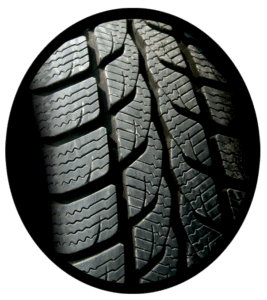
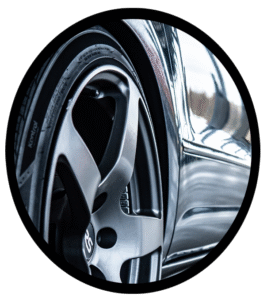
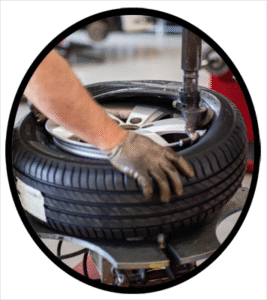


 CERTIFIED Mechanics
CERTIFIED Mechanics 
CERTIFIED Mechanics
Winter & Snow Tires Sales, Repair & Installation
Ohio Autocare provides comprehensive winter and snow tire sales, repair and installation for virtually all national winter tire brands. In addition to tire mounting and installation, we can also provide balancing, alignment and rotation.
With proper maintenance and regular tire rotations, modern automobile tires can achieve 60-70,000 or more miles, depending on driving habits, conditions, environment and the quality of the tires, themselves.
Rubber is the ideal material for automobile tires. It can absorb significant impacts as well as support over a ton of weight, yet still retains its round shape. But winter has a unique impact on standard automobile tires that the other three seasons typically do not. When the thermometer drops below 40°, natural rubber becomes more rigid and loses it’s elasticity. This makes the rubber more brittle and susceptible to damage and greatly affects the tire’s ability to maintain good traction. UV rays from the Sun combined with oil and chemicals from the road can also eat away at the rubber which can shorten its lifespan.
Ohio Autocare is a local service repair shop that is familiar with the regional terrain and conditions and can provide valuable incite when your tires become aged. Call or visit in one of our convenient locations in Columbus and Cincinnati.
Winter Tires Sales, Repair & Installation
For Winter & Snow Tire Sales, Service and Installation for your family or commercial fleet vehicles, Call the Ohio Autocare near you, or click the auto shop below for our convenient online scheduling app.
Winter & Snow Tires
Unless you frequent the Great Lakes area, Ohio winters are generally pretty mild. But its not unusual to stay below freezing for weeks with a few school-closing snow storms thrown in. But with the excellent work of our snow plow workers, many metropolitan areas are rarely snowed in for an extended period of time and feel comfortable not switching to a dedicated winter tire.
Rubber is the ideal material for automobile tires. It can absorb significant impacts as well as support over a ton of weight, yet still retains its round shape. But winter has a unique impact on standard automobile tires that the other three seasons typically do not. When the thermometer drops below 40°, natural rubber becomes more rigid and loses it’s elasticity. This makes the rubber more brittle and susceptible to damage and greatly affects the tire’s ability to maintain good traction. UV rays from the Sun combined with oil and chemicals from the road can also eat away at the rubber which can shorten the lifespan of the tire.
Winter tires are designed just for these conditions. Advances in synthetic rubbers have enabled manufacturers to blend in additives to the natural rubber to maintain its elasticity in temperatures well below zero. Combined with thick tread patterns, winter tires perform extremely well and can cut braking distances down to half of other tire types. In fact, many countries that experience frequent cold-weather events, like Canada, have made winter tires a requirement during winter months.
ABOUT WINTER & SNOW TIRES
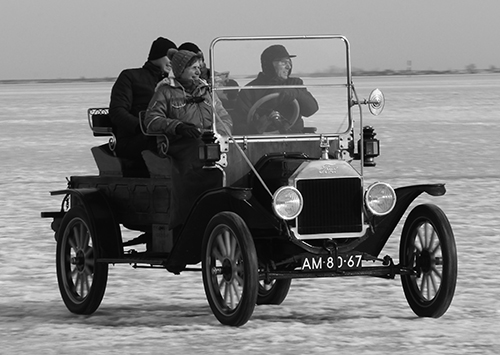
Many automobile components were inspired by the non-motorized crafts at the time, namely horse carriages and bicycles. The wheels are no different. As the automobile began to take shape, commonly the wheels had long spokes and were made of wood or metal. Some used leather to extend the life of the wheel and somewhat cushion the ride. Just as automobiles were starting to come into their own, bicycle manufacturers began to offer models with solid rubber tires.
The natural elasticity of rubber from the rubber tree made it an ideal solution for tires as it absorbed some of the blows from the road while protecting the rim from damage. The elasticity of rubber also provided excellent traction…in dry weather. Throw a little moisture onto the surface, though, and the rubber tires were nearly as hazardous as the wood and steel tires.
The solution again came from the bicycle industry. They determined a single embossed rib around the circumference of the rubber tire greatly improved traction. Around the same time, pneumatic tires were being developed. These tires featured a separate air-filled innertube and was a significant upgrade over the bone-jarring metal or wood wheels more commonly used over the crater-covered “roads” of the time.
“Roads” is a relative term as virtually no roads existed outside of cities. In population centers, some roads may have been gravel, wood planks or bricks, but these were designed more for bicycles and horse carriages rather than the occasional horseless carriage. Roadways developed specifically for automobiles began in the 1920’s with the development of concrete and asphalt.
A problem with natural rubber, though, was cold weather makes it more rigid. The farther temperatures drop below 40°, the harder the rubber becomes. This significantly reduces the tire’s ability to maintain good traction. This remained an issue until the 1930’s when synthetic rubber was developed. With synthetic rubber, tire manufacturers were able to specially formulate compounds to blend with the natural rubber and make it stronger, mold-resistant and remain elastic in much lower temperatures.
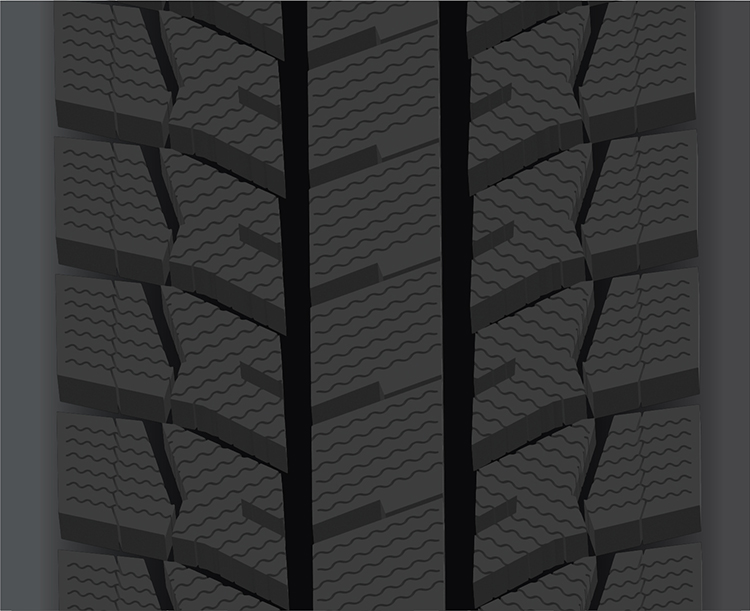
Manufacturers also began to analyze tire tread patterns. Early tread patterns were established more for a manufacturer’s identity than any water removal or safety enhancement. They soon learned how tire treads could aid in traction and stability and started adding perpendicular and angular channels to the main vertical ribs and were very effective in removing water from below the tire so it could still provide effective traction and reduce the risk of hydroplaning.
As tire manufacturing advanced further, more intricately designed tread patterns were designed. Borrowing some tread tech from the shoe industry, a dense lattice of smaller slits called sipes were added to deeper tread channels and were much more effective at maintaining traction on snow and ice. By the 1930’s, the formula was there for the first winter tire which was introduced in Finland. In the 1990’s, the Manufacturers Association created the snowflake and mountain symbol to distinguish tires specially made for better handling on snow and ice.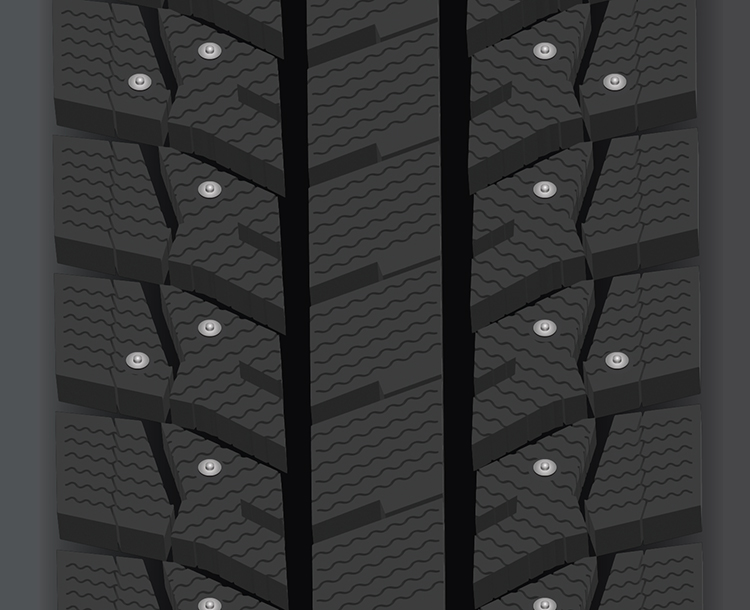
Studded Winter Tires
For even greater traction on the ice, studded winter tires are available. Studded metal tires have small metal studs inserted or screwed into the tire treads for use on more challenging terrain. Check laws and regulations in your area as some communities have banned the use of studded winter tires citing road and road markings damage.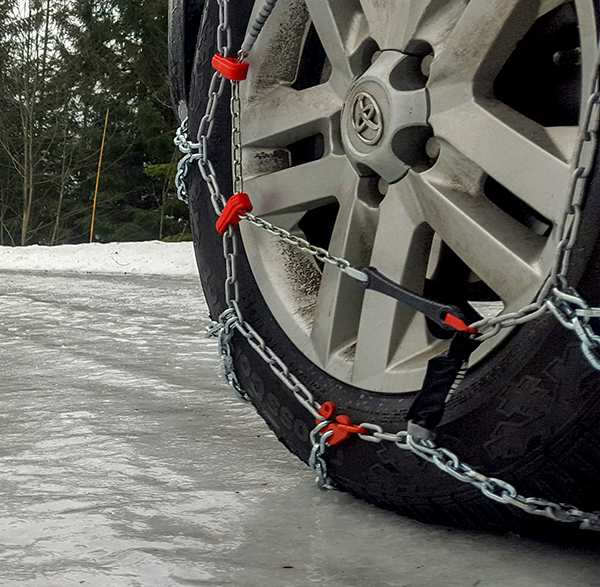
Winter Tire Chains
Chains can be wrapped around the tires for greater traction in extreme weather events. But just like studded winter tires, chains may not be permitted in your region.
Once winter finally leaves, it’s important to remove the winter tires. Winter tires are made for cold weather, but once the temperature rises, the winter tire rubber become vulnerable to damage from standard roadway impacts like rocks and potholes.
Unless you frequent the Great Lakes area, Ohio winters are generally pretty mild. But its not unusual to stay below freezing for weeks with a few school-closing snow storms thrown in. But with the excellent work of our snow plow workers, many metropolitan areas are rarely snowed in for an extended period of time and feel comfortable not switching to a dedicated winter tire.
Rubber is the ideal material for automobile tires. It can absorb significant impacts as well as support over a ton of weight, yet still retains its round shape. But winter has a unique impact on standard automobile tires that the other three seasons typically do not. When the thermometer drops below 40°, natural rubber becomes more rigid and loses it’s elasticity. This makes the rubber more brittle and susceptible to damage and greatly affects the tire’s ability to maintain good traction. UV rays from the Sun combined with oil and chemicals from the road can also eat away at the rubber which can shorten the lifespan of the tire.
Winter tires are designed just for these conditions. Advances in synthetic rubbers have enabled manufacturers to blend in additives to the natural rubber to maintain its elasticity in temperatures well below zero. Combined with thick tread patterns, winter tires perform extremely well and can cut braking distances down to half of other tire types. In fact, many countries that experience frequent cold-weather events, like Canada, have made winter tires a requirement during winter months.
ABOUT WINTER & SNOW TIRES

Many automobile components were inspired by the non-motorized crafts at the time, namely horse carriages and bicycles. The wheels are no different. As the automobile began to take shape, commonly the wheels had long spokes and were made of wood or metal. Some used leather to extend the life of the wheel and somewhat cushion the ride. Just as automobiles were starting to come into their own, bicycle manufacturers began to offer models with solid rubber tires.
The natural elasticity of rubber from the rubber tree made it an ideal solution for tires as it absorbed some of the blows from the road while protecting the rim from damage. The elasticity of rubber also provided excellent traction…in dry weather. Throw a little moisture onto the surface, though, and the rubber tires were nearly as hazardous as the wood and steel tires.
The solution again came from the bicycle industry. They determined a single embossed rib around the circumference of the rubber tire greatly improved traction. Around the same time, pneumatic tires were being developed. These tires featured a separate air-filled innertube and was a significant upgrade over the bone-jarring metal or wood wheels more commonly used over the crater-covered “roads” of the time.
“Roads” is a relative term as virtually no roads existed outside of cities. In population centers, some roads may have been gravel, wood planks or bricks, but these were designed more for bicycles and horse carriages rather than the occasional horseless carriage. Roadways developed specifically for automobiles began in the 1920’s with the development of concrete and asphalt.
A problem with natural rubber, though, was cold weather makes it more rigid. The farther temperatures drop below 40°, the harder the rubber becomes. This significantly reduces the tire’s ability to maintain good traction. This remained an issue until the 1930’s when synthetic rubber was developed. With synthetic rubber, tire manufacturers were able to specially formulate compounds to blend with the natural rubber and make it stronger, mold-resistant and remain elastic in much lower temperatures.

Manufacturers also began to analyze tire tread patterns. Early tread patterns were established more for a manufacturer’s identity than any water removal or safety enhancement. They soon learned how tire treads could aid in traction and stability and started adding perpendicular and angular channels to the main vertical ribs and were very effective in removing water from below the tire so it could still provide effective traction and reduce the risk of hydroplaning.
As tire manufacturing advanced further, more intricately designed tread patterns were designed. Borrowing some tread tech from the shoe industry, a dense lattice of smaller slits called sipes were added to deeper tread channels and were much more effective at maintaining traction on snow and ice. By the 1930’s, the formula was there for the first winter tire which was introduced in Finland. In the 1990’s, the Manufacturers Association created the snowflake and mountain symbol to distinguish tires specially made for better handling on snow and ice.
Studded Winter Tires
 For even greater traction on the ice, studded winter tires are available. Studded metal tires have small metal studs inserted or screwed into the tire treads for use on more challenging terrain. Check laws and regulations in your area as some communities have banned the use of studded winter tires citing road and road markings damage.
For even greater traction on the ice, studded winter tires are available. Studded metal tires have small metal studs inserted or screwed into the tire treads for use on more challenging terrain. Check laws and regulations in your area as some communities have banned the use of studded winter tires citing road and road markings damage.
Winter Tire Chains
 Chains can be wrapped around the tires for greater traction in extreme weather events. But just like studded winter tires, chains may not be permitted in your region.
Chains can be wrapped around the tires for greater traction in extreme weather events. But just like studded winter tires, chains may not be permitted in your region.
Once winter finally leaves, it’s important to remove the winter tires. Winter tires are made for cold weather, but once the temperature rises, the winter tire rubber become vulnerable to damage from standard roadway impacts like rocks and potholes.
